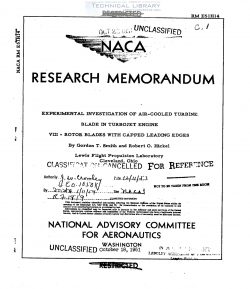naca-rm-e51h14
- Version
- 46 Downloads
- 1.13 MB File Size
- 1 File Count
- May 25, 2017 Create Date
- May 25, 2017 Last Updated
National Advisory Committee for Aeronautics, Research Memorandum - Experimental Investigation of Air Cooled Turbine Blade in Turbojet Engine - VIII - Rotor Blades with Capped Leading Edges

An air—cooled turbine blade having special provisions for cooling
the leading edge of the blade by introducing air under a leading-edge
cap was investigated in a modified production turbojet engine.
The cooling effectiveness was determined over a range of engine
speed from 4000 to _ZL'L,550 rpm. The cooling-air flowper blade was
varied from about 0.01 to about 0.1 pound per second. The results
indicated effective cooling of the leading edge of the blade. For
example, at an engine speed of 10,000 rpm, a coolant- to gas-flow ratio
of 0.054, and. an effective gas temperature of 10000 F, the leading—edge
temperature was about 400° F, which is about 250° F cooler than the most
effectively cooled leading-edge configuration previously investigated.
The cooling-air pressure loss through the blade, based on coolant flow
rate, was the lowest of any cooled—blade configuration so far investi-
gated.
A series of air-cooled turbine blade configurations are being
investigated at the NASA Lewis laboratory under conditions of.engine
operation in order to obtain a blade configuration which will permit
operation of blades fabricated from nonstrategic materials at current
or higher inlet gas temperatures. The analytical and experimental
research which preceded this program is reviewed in reference 1.
Previous investigations of three blade configurations (refer-
ences l to 5) establist that hollow blade shells containing tubes and
fine in the coolant passage were characterized by severe chordwise
temperature gradients. These configurations had we'll—cooled midchord
regions but were as much as 500° F hotter at the leading and trailing
edges of the blades than at the midchord. Analysis indicated. that the
high leading— and trailing-edge temperatures of these first blade
configurations might limit the operation of similar nonstrategic blades
to inlet temperatures below those now in use. Consequently, a series of
blade configurations featuring special modifications intended to reduce
the large chordwise temperature variations were fabricated and investi-
gated, The results of the investigation of the first six of these
special configurations are presented in.referenee 4. These blades were
designated as blades 4 to 9. FOur more blades of this series, blades 11
to 14, are reported in reference 5. The results obtained with a split
trailing edge (blade 10) intended to reduce the chordwise temperature
gradient at the trailing edge of the blade are reported in reference 6.
| File | Action |
|---|---|
| naca-rm-e51h14 Experimental Investigation of Air Cooled Turbine Blade in Turbojet Engine - VIII - Rotor Blades with Capped Leading Edges.pdf | Download |

Comment On This Post